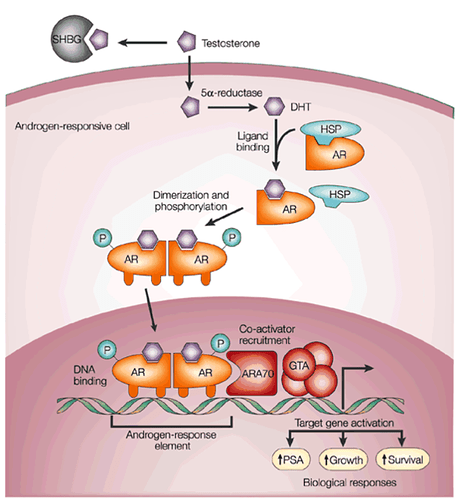Hello,
I’m Meso (Deya) from PSSD forum. Although I haven’t looked much into PFS, I’ve recently been looking into improving AR signaling and/or expression for PSSD - and have come to find an interesting lead.
I’ll cut to the chase: Heat shock proteins (HSPs).
In castration-resistant prostate cancer (CRPC), androgen receptors continue to signal despite of androgen deficiency. This is due to, as suggested, the binding of HSP27 to AR homodimer: supporting its trafficking to the nucleus where it can bind specific DNA sequences known as androgen response element (ARE).
In prostate cancer, HSP27 are over-induced due to the dire environment cancer cells have to endure. This leads to persistent AR signaling despite of castration (complete androgen deprivation).
As I’ve come to understand it, post-finasteride syndrome (PFS) is a condition where AR are over-expressed but are simultaneously silenced. Let that be due to methylation or something else.
I thought I’d share this as HSP27 should be interesting for you. It would facilitate AR-to-ARE without affecting AR expression. Theoretically, it should bring your silenced AR to life - at least partially.
HSP70 and HSP90 and their co-chaperones have more to do with AR expression, so they are more beneficial to PSSD than to PFS.
Unfortunately, theoretical data doesn’t always translate to practical outcomes. Being pragmatic, it’s essential not to put too much hope on this until HSP27-inducers are experimented with.
I’ve looked up what substances can achieve this:
- Schisandrin B (HSP27 and HSP70 + BDNF/TrkB upregulation).
- Shikonin/Alkannin (Unspecified)
- Bimoclomol (Improves HSP function)
- FLZ (HSP27 and HSP70 + BDNF/TrkB enhancer)
Keep in mind that I haven’t looked too much into these substance to know all their other mechanisms of action. For instance, I know that Schisandra is an AChEI and boosts serotonin, and dopamine. I know that Shikonin inhibits estradiol synthesis - which can be a very bad thing.
As such, this is just preliminary work. The reason I’m sharing this in its early stage is to ask you this: Have you ever tried any of the above substances/extracts for at least 3 months at a sufficiently high dose?
More on TrkB receptor upregulation and BDNF boosting:
It was found that BDNF can restore sexual function in castrated rats by its own (thanks to taarn for pointing this out). I believe this is due to:
- BDNF/TrkB --> CK2 activation --> induction of HSP90/Cdc37 complex --> induction of AR transcriptional activity
- BDNF/TrkB --> limbic dopamine receptors upregulation
- BDNF/TrkB --> neurotrophy, neurogenesis/synaptogenesis --> improved limbic integry
- BDNF/TrkB --> SERT upregulation --> lowering of serotonin
- BDNF/TrkB --> facilitated phasic glutamate firing (phasic is the good type).
So, a potent schisandra extract taken for at least 3 months should benefit PSSD through various pathways. Theoretically.
References (for the entire post):
[https://www.ncbi.nlm.nih.gov/pubmed/29750970]
[https://www.ncbi.nlm.nih.gov/pubmed/29092774]
[https://www.ncbi.nlm.nih.gov/pubmed/23385973]
[https://www.ncbi.nlm.nih.gov/pmc/articles/PMC6721600/]
[http://www.cjphysiology.org/article.asp?issn=0304-4920;year=2019;volume=62;issue=2;spage=63;epage=69;aulast=Yang;type=0]
[https://www.ncbi.nlm.nih.gov/pubmed/10551783]
[https://www.ncbi.nlm.nih.gov/pubmed/17360365]
[https://onlinelibrary.wiley.com/doi/pdf/10.1111/jgh.12425]
Thank you for reading.

